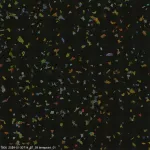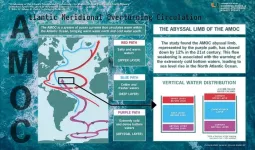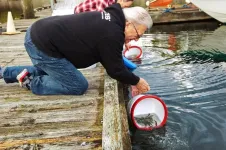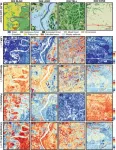(Press-News.org) Observing proteins precisely within cells is extremely important for many branches of research but has been a significant technical challenge - especially in living cells, as the required fluorescent labelling had to be individually attached to each protein. The research group led by Stefan Kubicek at CeMM has now overcome this hurdle: With a method called "vpCells," it is possible to label many proteins simultaneously, using five different fluorescent colours. This automated high-throughput approach, aided by AI-assisted image recognition, opens up entirely new applications in various disciplines, from fundamental cell biology to drug discovery. The study has been published in the journal Nature Cell Biology (DOI: 10.1038/s41556-024-01407-w), and the related images are available at vpcells.cemm.at.
Without proteins, life as we know it would be inconceivable. They provide the structural framework for cells, act as enzymes to control metabolism, and enable cells to communicate with their environment as membrane receptors, transporters, or signalling molecules. All of these functions can only be fulfilled if the proteins are located in the right place within the cell. Often, even the properties of a protein change when it changes its location - control over its localization in the cell therefore also means control over its function.
To understand and explore the function of proteins, it is essential to precisely determine and track their location within the cell. Proteins often shuttle dynamically between different organelles and compartments of the cell. To visualize them under the microscope, they are often linked to a fluorescent, brightly shining protein component. However, this method has faced technical difficulties: Typically, the fluorescent component could only be attached to one protein at a time, and to label multiple proteins, cells usually had to be killed and fixed.
The new method presented by Stefan Kubicek's group, called "visual proteomics Cells" (abbreviated vpCells), allows proteins to be fluorescently labelled in a way that preserves their endogenous regulatory mechanisms. Instead of labelling one protein at a time, vpCells can fuse many proteins simultaneously with a fluorescent tag in a so-called multiplex approach. A precursor of this method was already described by Kubicek's team in 2020 for studying metabolic enzymes (Reicher et al. Genome Res. 2020, DOI: 10.1101/gr.261503.120). Now it has been expanded and improved in three ways:
Firstly, vpCells can label all theoretically possible proteins using the CRISPR/Cas9 gene-editing tool to genetically attach fluorescent proteins to the proteins under investigation. Kubicek's group has created a genome-wide "library" for this purpose, enabling the fluorescent marking and systematic functional exploration of all possible human proteins.
Secondly, vpCells use not only one fluorescent colour but a total of five complementary colours. In each cell, two different proteins to be tracked are marked. Additionally, another colour marking is used to better distinguish individual clones. And two further colours mark the cell nucleus and membrane to delineate individual cells better.
Thirdly, this colour scheme enables not only to generate visually appealing images, but also to optically recognize and discriminate the different proteins . Normally, this requires complex DNA sequencing after imaging to determine which protein is labelled. The vpCells approach, on the other hand, enables training an AI-assisted image recognition system to recognize which protein is marked in which cell based solely on fluorescence microscopy images.
The method has already demonstrated its utility in two applications: On the one hand, more than 4,500 cell lines were generated as reporters for more than 1,100 proteins. These cell lines were used to train the AI models and to describe localization of the proteins in their basal state. All images of the individual labelled proteins are available on the publicly accessible web database vpcells.cemm.at.
On the other hand, the living reporter cells were used for a specific research question: Kubicek's team examined the effect of more than 1000 small-molecule substances on 61 proteins relevant to cancer cells. The researchers found that 44 of the tested substances altered the amount or localization of individual proteins within 6 hours. One of the substances turned out to be an inhibitor of protein transport from the cell nucleus, which has a similar effect to a clinically approved drug for multiple myeloma, a cancer of the blood-forming system.
"These results provide a first glimpse into the versatility of the vpCells method," says Kubicek. "We expect many more future applications , from fundamental cell biology to applied drug discovery."
***
The Study “Pooled multicolor tagging for visualizing subcellular protein dynamics” was published in Nature Cell Biology on April 19, 2024 . DOI: 10.1038/s41556-024-01407-w
Authors: Andreas Reicher, Jiří Reiniš, Maria Ciobanu, Pavel Růžička, Monika Malik, Marton Siklos, Viktoriia Kartysh, Tatjana Tomek, Anna Koren, André F. Rendeiro, Stefan Kubicek
Funding: Andreas Reicher was supported by a Boehringer Ingelheim Fonds PhD fellowship, André Rendeiro by Angelini Ventures S.p.A. Rome, Italy. Research in the Kubicek lab has been supported by the Austrian Academy of Sciences, the European Research Council (ERC) under the European Union’s Horizon 2020 research and innovation program, the Austrian Science Fund (FWF), and the Vienna Science and Technology Fund (WWTF).
Stefan Kubicek joined CeMM in 2010. He obtained an MSc in Synthetic Organic Chemistry from the Vienna University of Technology after writing a diploma thesis at ETH Zurich. For his PhD in Thomas Jenuwein’s lab at the IMP in Vienna, he changed fields to molecular biology and developed the first selective histone methyl transferase inhibitors. He then performed postdoctoral research, working on chemical biology with Stuart Schreiber at the Broad Institute of Harvard and MIT. At CeMM, Stefan Kubicek headed the Christian Doppler Laboratory for Chemical Epigenetics and Antiinfectives, a public-private partnership between CeMM, Boehringer Ingelheim, and Haplogen, and is now the head of the CeMM Molecular Discovery Platform. The Kubicek lab is working on the role of chromatin in the definition of cell types and cell states, in particular chromatin-modifying enzymes as synthetic lethal targets in cancer and chemical transdifferentiation to insulin-producing beta cells. In an ERC-funded project, the laboratory studies metabolic enzymes in the cell’s nucleus to test the hypothesis that small molecule metabolites shape chromatin structure and thus control gene expression and cell identity.
The CeMM Research Center for Molecular Medicine of the Austrian Academy of Sciences is an international, independent and interdisciplinary research institution for molecular medicine under the scientific direction of Giulio Superti-Furga. CeMM is oriented towards medical needs and integrates basic research and clinical expertise to develop innovative diagnostic and therapeutic approaches for precision medicine. Research focuses on cancer, inflammation, metabolic and immune disorders, and rare diseases. The Institute's research building is located on the campus of the Medical University and the Vienna General Hospital.
www.cemm.at
For further information please contact:
Stefan Bernhardt
PR & Communications Manager
CeMM
Research Center for Molecular Medicine
of the Austrian Academy of Sciences
Lazarettgasse 14, AKH BT 25.3
1090 Vienna, Austria
Phone +43-1/40160-70 056
Fax +43-1/40160-970 000
sbernhardt@cemm.at
END
Light show in living cells
New method allows simultaneous fluorescent labelling of many proteins
2024-04-19
ELSE PRESS RELEASES FROM THIS DATE:
Climate change will increase value of residential rooftop solar panels across US, study shows
2024-04-19
Graphic
Climate change will increase the future value of residential rooftop solar panels across the United States by up to 19% by the end of the century, according to a new University of Michigan-led study.
The study defines the value of solar, or VOS, as household-level financial benefits from electricity bill savings plus revenues from selling excess electricity to the grid—minus the initial installation costs.
For many U.S. households, increased earnings from residential rooftop ...
Could the liver hold the key to better cancer treatments?
2024-04-19
PHILADELPHIA – Liver inflammation, a common side-effect of cancers elsewhere in the body, has long been associated with worse cancer outcomes and more recently associated with poor response to immunotherapy. Now, a team led by researchers from the Abramson Cancer Center and Perelman School of Medicine at the University of Pennsylvania has found a big reason why.
In their study, published today in Nature Immunology, the researchers discovered that cancer-induced liver inflammation causes liver cells to secrete proteins called serum amyloid A (SAA) proteins, which circulate through the body and hinder the ability of T cells—major anticancer weapons of the immune system—to ...
Warming of Antarctic deep-sea waters contribute to sea level rise in North Atlantic, study finds
2024-04-19
Analysis of mooring observations and hydrographic data suggest the Atlantic Meridional Overturning Circulation deep water limb in the North Atlantic has weakened. Two decades of continual observations provide a greater understanding of the Earth’s climate regulating system.
A new study published in the journal Nature Geoscience led by scientists at University of Miami Rosenstiel School of Marine, Atmospheric, and Earth Science, and the National Oceanic and Atmospheric Administration’s Atlantic ...
Study opens new avenue for immunotherapy drug development
2024-04-19
HOUSTON ― In a new study published today in Nature Biomedical Engineering, researchers at The University of Texas MD Anderson Cancer Center have designed a new method for developing immunotherapy drugs using engineered peptides to elicit a natural immune response inside the body.
In preclinical models of locally advanced and metastatic breast cancer, this method improved tumor control and prolonged survival, both as a monotherapy and in combination with immune checkpoint inhibitors.
“Amino acids are the building blocks of life and, when a few of them are linked together, they create a peptide. ...
Baby sharks prefer being closer to shore, show scientists
2024-04-19
Remember #BabyShark? And no, this was not the very catchy song for kids that took the internet by storm. Earlier this year, social media was abuzz with stunning footage of a newborn great white shark, captured by a flying drone.
Now, marine scientists have shown for the first time that juvenile great white sharks select warm and shallow waters to aggregate within one kilometer from the shore. These results, published in Frontiers in Marine Science, are important for conservation of great white sharks – especially as ocean temperatures increase due ...
UBC research helps migrating salmon survive mortality hot-spot
2024-04-19
When Kevin Ryan and the other hardworking volunteers at Mossom Creek Hatchery in Port Moody, B.C. release young coho smolts into the ocean, they’re never quite certain how many will return as adults.
Mossom releases between 5,000 and 10,000 coho smolts each year, and is one of the few hatcheries to release coho directly into the ocean, rather than into a river. Until now, no research had looked at the success of direct ocean releases of coho.
UBC researchers used acoustic telemetry to tag and track coho on their journey. The results were revealing: ...
Technical Trials for Easing the (Cosmological) Tension
2024-04-19
Thanks to the dizzying growth of cosmic observations and measurement tools and some new advancements (primarily the “discovery” of what we call dark matter and dark energy) all against the backdrop of General Relativity, the early 2000s were a time when nothing seemed capable of challenging the advancement of our knowledge about the cosmos, its origins, and its future evolution.
Even though we were aware there was still much to uncover, the apparent agreement between our observations, calculations, and theoretical framework was indicating that our knowledge of the universe was set to grow significantly and without ...
Mapping plant functional diversity from space: HKU ecologists revolutionize ecosystem monitoring with novel field-satellite integration
2024-04-19
An international team of researchers, led by Professor Jin WU from the School of Biological Sciences at The University of Hong Kong (HKU), has made a promising advancement in mapping plant functional traits from space using time-series satellite data. The study, published in Remote Sensing of Environment, showcases the innovative combination of the Sentinel-2 satellite mission and its dynamic time-series capabilities. This innovative approach not only unlocks a deeper understanding of essential foliar traits, providing crucial insights ...
Lightweight and flexible yet strong? Versatile fibers with dramatically improved energy storage capacity
2024-04-19
The latest wearable devices, such as Samsung's Galaxy Ring and Apple's Vision Pro, are taking healthcare a step further and even enabling people to work virtually. Given the characteristics of wearable devices that require them to be small and lightweight, there is an inevitable limitation on battery capacity, still presenting a technical barrier to incorporating a variety of functions. In order for wearable devices to fully realize the imagined life, it is necessary to develop a lighter and more fromlessenergy storage method.
The Korea Institute of Science and Technology (KIST) announced that a joint research team led by Dr. Hyeonsu Jeong ...
3 ways to improve diabetes care through telehealth
2024-04-19
Grocery stores, airports and beaches aren’t great places to have telehealth visits with your endocrinologist. But home can be one of the best locations, giving a doctor helpful insights into a patient’s home environment, which can positively impact their care.
This is just one finding shared in a new study published this week in The Journal of Clinical Diabetes.
Researchers interviewed clinicians and staff who provide diabetes care through telehealth across four University of California academic medical ...
LAST 30 PRESS RELEASES:
Practical education: Clinical scenario-based program development
The impact of family dynamics on eating behaviour – how going home for Christmas can change how you eat
Tracing the quick synthesis of an industrially important catalyst
New software sheds light on cancer’s hidden genetic networks
UT Health San Antonio awarded $3 million in CPRIT grants to bolster cancer research and prevention efforts in South Texas
Third symposium spotlights global challenge of new contaminants in China’s fight against pollution
From straw to soil harmony: International team reveals how biochar supercharges carbon-smart farming
Myeloma: How AI is redrawing the map of cancer care
Manhattan E. Charurat, Ph.D., MHS invested as the Homer and Martha Gudelsky Distinguished Professor in Medicine at the University of Maryland School of Medicine
Insilico Medicine’s Pharma.AI Q4 Winter Launch Recap: Revolutionizing drug discovery with cutting-edge AI innovations, accelerating the path to pharmaceutical superintelligence
Nanoplastics have diet-dependent impacts on digestive system health
Brain neuron death occurs throughout life and increases with age, a natural human protein drug may halt neuron death in Alzheimer’s disease
SPIE and CLP announce the recipients of the 2025 Advanced Photonics Young Innovator Award
Lessons from the Caldor Fire’s Christmas Valley ‘Miracle’
Ant societies rose by trading individual protection for collective power
Research reveals how ancient viral DNA shapes early embryonic development
A molecular gatekeeper that controls protein synthesis
New ‘cloaking device’ concept to shield sensitive tech from magnetic fields
Researchers show impact of mountain building and climate change on alpine biodiversity
Study models the transition from Neanderthals to modern humans in Europe
University of Phoenix College of Doctoral Studies releases white paper on AI-driven skilling to reduce burnout and restore worker autonomy
AIs fail at the game of visual “telephone”
The levers for a sustainable food system
Potential changes in US homelessness by ending federal support for housing first programs
Vulnerability of large language models to prompt injection when providing medical advice
Researchers develop new system for high-energy-density, long-life, multi-electron transfer bromine-based flow batteries
Ending federal support for housing first programs could increase U.S. homelessness by 5% in one year, new JAMA study finds
New research uncovers molecular ‘safety switch’ shielding cancers from immune attack
Bacteria resisting viral infection can still sink carbon to ocean floor
Younger biological age may increase depression risk in older women during COVID-19
[Press-News.org] Light show in living cellsNew method allows simultaneous fluorescent labelling of many proteins










